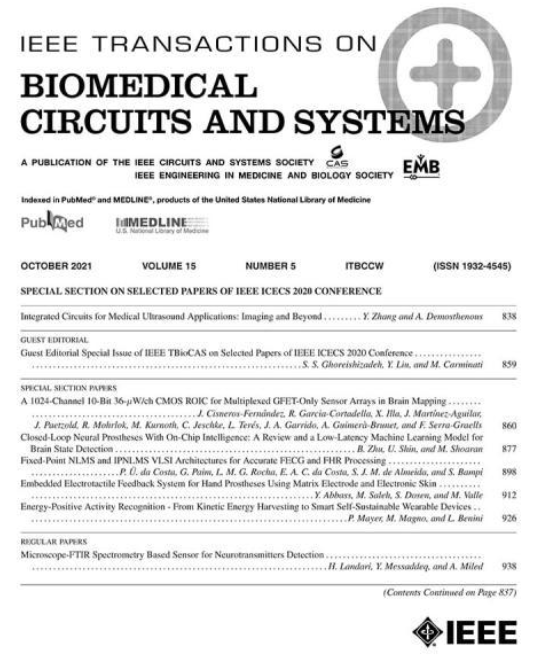一种基于芯片的酶动力学和代谢物定量分析集成电路
IF 4.9
2区 医学
Q2 ENGINEERING, BIOMEDICAL
IEEE Transactions on Biomedical Circuits and Systems
Pub Date : 2016-01-06
DOI:10.1109/TBCAS.2015.2487603
引用次数: 31
摘要
我们已经创造了一种新的基于芯片的诊断工具,该工具基于使用特定于其化学转化的酶对代谢物进行量化。利用这种装置,我们首次证明了固态电路可以用于测量酶动力学和计算Michaelis-Menten常数。底物浓度对酶反应速率的依赖性是这一目标的核心。离子敏感场效应晶体管(ISFET)是依赖于酶分析的生物传感应用的优秀换能器,特别是因为它们可以使用主流微电子技术制造,以确保低单位成本,大规模生产,缩放以制造许多传感器,并直接小型化用于护理点设备。在这里,我们描述了一个集成的ISFET阵列,包括216个传感器。该器件采用互补金属氧化物半导体(CMOS)工艺制造。与传统的CMOS ISFET传感器使用铸造厂的Si3N4钝化进行离子检测不同,这里报道的器件用Ta2O5层处理,在传感器读出时将检测灵敏度提高到45 mV/pH单位。漂移降低到0.8 mV/h, pH值在2 ~ 12之间呈线性响应。开发了一种能够获取近500 fps的高速仪器系统来输出数据。然后用该装置通过己糖激酶活性在0.05 mM-231 mM范围内测量葡萄糖浓度,该范围包括血液中葡萄糖的生理范围。详细研究了己糖激酶的局部和时间酶动力学。这些结果为可行的个人代谢组机器提供了路线图。本文章由计算机程序翻译,如有差异,请以英文原文为准。
An Integrated Circuit for Chip-Based Analysis of Enzyme Kinetics and Metabolite Quantification
We have created a novel chip-based diagnostic tools based upon quantification of metabolites using enzymes specific for their chemical conversion. Using this device we show for the first time that a solid-state circuit can be used to measure enzyme kinetics and calculate the Michaelis-Menten constant. Substrate concentration dependency of enzyme reaction rates is central to this aim. Ion-sensitive field effect transistors (ISFET) are excellent transducers for biosensing applications that are reliant upon enzyme assays, especially since they can be fabricated using mainstream microelectronics technology to ensure low unit cost, mass-manufacture, scaling to make many sensors and straightforward miniaturisation for use in point-of-care devices. Here, we describe an integrated ISFET array comprising 216 sensors. The device was fabricated with a complementary metal oxide semiconductor (CMOS) process. Unlike traditional CMOS ISFET sensors that use the Si3N4 passivation of the foundry for ion detection, the device reported here was processed with a layer of Ta2O5 that increased the detection sensitivity to 45 mV/pH unit at the sensor readout. The drift was reduced to 0.8 mV/hour with a linear pH response between pH 2-12. A high-speed instrumentation system capable of acquiring nearly 500 fps was developed to stream out the data. The device was then used to measure glucose concentration through the activity of hexokinase in the range of 0.05 mM-231 mM, encompassing glucose's physiological range in blood. Localised and temporal enzyme kinetics of hexokinase was studied in detail. These results present a roadmap towards a viable personal metabolome machine.
求助全文
通过发布文献求助,成功后即可免费获取论文全文。
去求助
来源期刊

IEEE Transactions on Biomedical Circuits and Systems
工程技术-工程:电子与电气
CiteScore
10.00
自引率
13.70%
发文量
174
审稿时长
3 months
期刊介绍:
The IEEE Transactions on Biomedical Circuits and Systems addresses areas at the crossroads of Circuits and Systems and Life Sciences. The main emphasis is on microelectronic issues in a wide range of applications found in life sciences, physical sciences and engineering. The primary goal of the journal is to bridge the unique scientific and technical activities of the Circuits and Systems Society to a wide variety of related areas such as: • Bioelectronics • Implantable and wearable electronics like cochlear and retinal prosthesis, motor control, etc. • Biotechnology sensor circuits, integrated systems, and networks • Micropower imaging technology • BioMEMS • Lab-on-chip Bio-nanotechnology • Organic Semiconductors • Biomedical Engineering • Genomics and Proteomics • Neuromorphic Engineering • Smart sensors • Low power micro- and nanoelectronics • Mixed-mode system-on-chip • Wireless technology • Gene circuits and molecular circuits • System biology • Brain science and engineering: such as neuro-informatics, neural prosthesis, cognitive engineering, brain computer interface • Healthcare: information technology for biomedical, epidemiology, and other related life science applications. General, theoretical, and application-oriented papers in the abovementioned technical areas with a Circuits and Systems perspective are encouraged to publish in TBioCAS. Of special interest are biomedical-oriented papers with a Circuits and Systems angle.
 求助内容:
求助内容: 应助结果提醒方式:
应助结果提醒方式:


